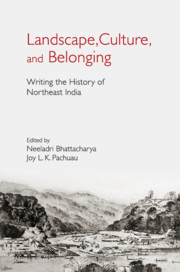Book contents
- Frontmatter
- Contents
- List of Figures
- Acknowledgements
- Introduction
- I Borders and Beyond
- II Surveys and Explorations
- III Ethnography, History, and the Politics of Representation
- 6 Naga: Lineages of a Term
- 7 Representing the Nagas: Negotiating National Culture and Consumption
- IV Law, State, and Practices of Governance
- V Cultural Dialogues
- Notes on Contributors
- Index
7 - Representing the Nagas: Negotiating National Culture and Consumption
from III - Ethnography, History, and the Politics of Representation
Published online by Cambridge University Press: 26 April 2019
- Frontmatter
- Contents
- List of Figures
- Acknowledgements
- Introduction
- I Borders and Beyond
- II Surveys and Explorations
- III Ethnography, History, and the Politics of Representation
- 6 Naga: Lineages of a Term
- 7 Representing the Nagas: Negotiating National Culture and Consumption
- IV Law, State, and Practices of Governance
- V Cultural Dialogues
- Notes on Contributors
- Index
Summary
Introduction
In a recent UK radio programme, Excess Baggage, the host interviewed a traveller to Nagaland (in India) and the German writer of several photo-journalistic compilations on the Nagas, Peter van Ham. A routine repertoire of questions was asked: about the geography of the Nagas, headhunting, the impact of modernity, and the preservation of ‘traditional culture’. As I listened to the programme, it became apparent that the Nagas were being portrayed in a manner that created an element of mystique and wonderment. Snippets of the choral chanting of women, the heaving of men as they pulled a log drum to a hilltop (‘900 strong men’, Peter van Ham says), engaged the listener as ample sound bites are provided of a land that only a few foreigners have ever seen. Questions about travel, access, and the future of tourism filled the airtime, as the programme participants mused about a quickly disappearing culture in an isolated corner of the world.
Travel is difficult, advises van Ham at one point, but encourages those who appreciate oral traditions and are culturally sensitive to sacrifice comfort for learning. We hear little of the life of modern Nagaland, visible in the vast network of cable televisions, restaurants, cafes, vehicles, theatres, and shopping centres. In this radio programme, it appeared as if the Nagas have been protected from the advent of modernity such that, at one point, the interviewer asked, ‘Do they have mobile phones?’ I kept wondering, were these images all that Nagaland ever has to offer? And the unnerving question that came to my mind was: Why are these the prevailing images of the Nagas and that of Nagaland? This chapter is an attempt to answer these questions.
The aim of this chapter is to examine how the Nagas are represented. There are two processes through which this is unravelled. The first is through the image of the Nagas, which generally tends to lean towards ‘exoticism’. This is a process that started in the early representations of the Nagas through British colonial contact. The British used descriptive and visual mediums to depict the Nagas (savages, headhunters, warriors) that have had a lasting impact on the perception of the Nagas.
- Type
- Chapter
- Information
- Landscape, Culture, and BelongingWriting the History of Northeast India, pp. 151 - 176Publisher: Cambridge University PressPrint publication year: 2019
- 2
- Cited by



